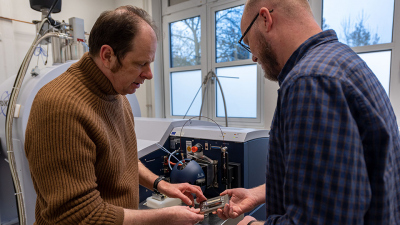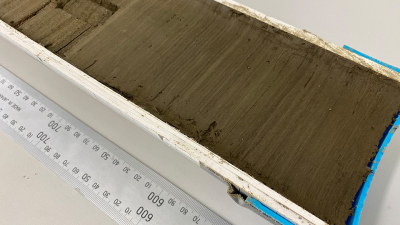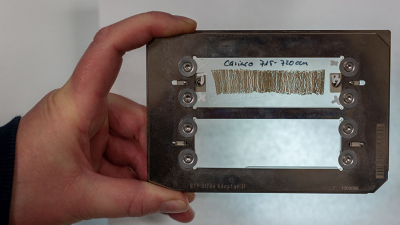- Home
- Discover
- Media Releases
- Media Releases 2022
- Lipid-Biomarker
Climate archives under the magnifying glass

The fossil remains of algae continuously accumulate in marine sediments, and these can be used to reconstruct past oceanic conditions. Molecular fossils, called lipid biomarkers, are of particular importance for this. They are the cellular building blocks of algae that populated the past ocean. When algae die and sink to the ocean floor, information relating to the environmental conditions during their lives is preserved in their lipids. In recent decades, analyses of these kinds of climate archives have been providing fundamental information that helps in our understanding of past climate changes.
A special tool for hidden details
In particular locations, for example, in the Cariaco Basin off the coast of Venezuela, very special laminated sediment archives are formed. “The Cariaco Basin is special because the deposits preserve thousands of years of well-sorted seasonal records that include a thin layer for each summer and one for every winter. The archive thus contains fundamental information about past short-term climate fluctuations in the tropics that have not been decipherable before now,” says first author Dr. Lars Wörmer of MARUM. He and his colleagues compare this situation to the fine print encountered in some documents, the reading of which may require the help of special devices. In the case of the sediments, the ‘reading aid’ is a laser coupled with an especially powerful mass spectrometer, which allows them to determine the distribution of lipid biomarkers in each one of the millimeter-thick layers.
Prof. Kai-Uwe Hinrichs, whose working group developed the method, calls it “a tool to decode the previously hidden details in climate archives.” In a project funded by the European Research Council (ERC), Hinrichs and his colleagues have developed a molecular imaging technique to map the climatic and environmental processes of the Earth's recent history at a high temporal resolution, i.e., almost in monthly intervals. Other analytical methods are used to reliably map intervals of hundreds or thousands of years, which, considering an Earth history of more than four billion years, has already been regarded as very detailed.
Global changes affect local temperatures
The time interval of the study encompasses a recent period of Earth’s history that was characterized by significant, abrupt warming not caused by humans. “This is viewed as a parallel to today,” explains Lars Wörmer. “The warming that occurred 11,700 years ago brought us into the Holocene, our present epoch. Further warming is now taking us from the Holocene into what we call the Anthropocene, which is characterized by anthropogenic climatic warming and environmental changes.” Kai-Uwe Hinrichs, Lars Wörmer and their team have shown that the difference between summer and winter temperatures doubled in the tropical ocean during this period. This provides evidence of how global climate changes affect local, seasonal temperature variations.
A MARUM study also based on the new method had already been published in September in Nature Geosciences. That study produced data that revealed sea-surface temperature history with a resolution of one to four years. In it, first author Dr. Igor Obreht and his colleagues investigated a sediment core from the eastern Mediterranean documenting temperatures from the last interglacial period (from around 129,000 to 116,000 years ago). The study by Obreht and colleagues thus centered on the last time that temperatures were warmer than they are today.
Scenarios for this kind of warmer Earth are being developed within the Cluster of Excellence “The Ocean Floor – Earth’s Uncharted Interface”, which is housed at MARUM. The GeoBiomolecular Imaging Lab, established through the ERC project mentioned above, is now a part of the infrastructure for supporting investigations under the Research Objectives of the Cluster of Excellence.
MARUM produces fundamental scientific knowledge about the role of the ocean and the seafloor in the total Earth system. The dynamics of the oceans and the seabed significantly impact the entire Earth system through the interaction of geological, physical, biological and chemical processes. These influence both the climate and the global carbon cycle, resulting in the creation of unique biological systems. MARUM is committed to fundamental and unbiased research in the interests of society, the marine environment, and in accordance with the sustainability goals of the United Nations. It publishes its quality-assured scientific data to make it publicly available. MARUM informs the public about new discoveries in the marine environment and provides practical knowledge through its dialogue with society. MARUM cooperation with companies and industrial partners is carried out in accordance with its goal of protecting the marine environment.

Original publication:
Lars Wörmer, Jenny Wendt, Brenna Boehman, Gerald Haug, Kai-Uwe Hinrichs: Deglacial increase of seasonal temperature variability in the tropical ocean. Nature 2022. DOI: 10.1038/s41586-022-05350-4
Contact:
Dr. Lars Wörmer
MARUM – Center for Marine Environmental Sciences, University of Bremen
Organic Geochemistry
Phone: +49 421 218-65710
Email: [Bitte aktivieren Sie Javascript]
More information:
Press release publication Nature Geosciences (Obreht et al.)
Cluster of Excellence „Ocean Floor“
Participating institutions:
MARUM – Center for Marine Environmental Sciences, University of Bremen
Max Planck Institute for Chemistry, Mainz
ETH Zürich (Switzerland)



